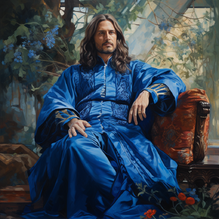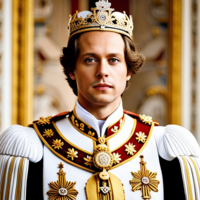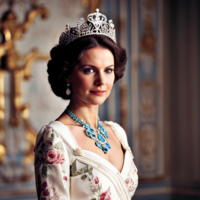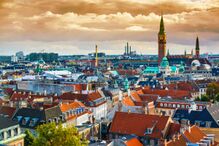Aureumterra
The Empire of Aureumterra Aureustáð Stórveldi | |
|---|---|
| Motto: Fyrir Stórveldi og Hæstirétt | |
| Anthem: Stórveldisøngur | |
| Capital and largest city | Potens (Potansað) |
| Official languages | Aureumterran (Aureustáðensk) |
| Recognised regional languages | Põjhamaa |
| Ethnic groups (2023) |
|
| Demonym(s) | Aureumterran |
| Government | Unitary Theocratic Absolute Monarchy |
• Hæstirétt | Frederik IV |
• Chief Minister | Jørne Bonde |
| Legislature | Imperial Consultative Assembly |
| Established | |
| 1060 AD | |
| Population | |
• 2023 estimate | 64 Million |
• Density | 114.53/km2 (296.6/sq mi) |
| GDP (nominal) | 2023 estimate |
• Total | $1.36 trillion |
• Per capita | $14,000 |
| HDI (2023) | 0.808 very high |
| Currency | Aureumterran Króna (kr.) |
| Date format | dd/mm/yyyy FIV |
| Driving side | right |
| Internet TLD | +45 |
Aureumterra, officially known as the Holy Empire of Aureumterra (Aureustáð Stórveldi) and internallly as simply Det Stórveldi ("The Empire") is a sovereign state located in Northern Belisaria, bordering Pueramaa and Lumisaari, Ostrozava, Merovia, and Ozonne. To the North, it borders the Nordic Sea. Aureumterra is a Unitary Theocratic Absolute Monarchy with its capital in the city of Potens, which is also the largest urban area. Other major cities include the port cities of Drødal and Alleden, Lagomvík and Eyjanes in the South, and Vjallborg near the border with Pueramaa.
The area of what is now Aureumterra, commonly called the Northern Belisarian Plain, was inhabited by various clans and tribes for centuries with no centralized authority among them. The modern state of Aureumterra emerged from the Åltæden, one of the many warring clans of the plains that dominate its area of Northern Belisaria, and one which had converted to Christian Sarpetism at some point prior to the 10th century. In the late 11th century, under Cnut I, the Åltæden rapidly conquered and united the region under one centralized authority for the first time in recorded history, with him proclaiming himself Hæstirétt (Emperor). The Aureumterran Empire and its state church, the Veldikirkjan (Imperial Church) was officially founded by Cnut I, designating the clan as the divinely elect eternal link between God and Earth and himself and his successors as the supreme spiritual and political authority in the Empire.
The Empire would go on to centralize and play a key role in the region as a major regional power throughout the Late Middle Ages and Early Modern Period. It retained its absolutist system of government and state church in an arrangement sometimes labelled a theocratic monarchy, despite various periods of social and political upheavel within and around its borders. Its continued use of serfdom into the 18th century and slowness to industrialize its economy left it behind most of Belisaria by the 19th century, only making slow progress towards economic parity towards the turn of the 20th century. The Empire then underwent a period of slow but stable growth in the early 20th century which saw it emerge as a key regional player and military power in the context of wider conflicts in Belisaria and beyond. Following a major period of stagnation in the 60s and the largest economic crisis in its history, Aureumterra underwent major social and political upheavel known as the Years of Chaos, which ended with the enthronement of Lisette II in 1979. This was followed by a period of rapid economic growth under a centralized wheel-and-spoke economic model, which saw some of the fastest GDP growth rates in the world during the late 20th and early 21st centuries, and Aureumterra emerging as one of the largest centers of international investment and manufacturing through its petroleum and plastics industry.
Today (The era known in Aureumterran historiography as the Fourth Frederikian Era), Aureumterra is one of the fastest growing economies in the world, serving as one of the primary manufacturing hubs. It is a net petroleum exporter, and home to the largest plastics manufacturing industry on the continent. It maintains a lower-upper income economy and a fairly high human development index, albeit behind most of the rest of Belisaria. The Empire plays a major role in global trade and maintains economic ties with the majority of other countries. It also has diplomatic and military ties to countries in its region, playing a role as a regional power in Northern Belisaria. It notably has the xth largest military in the world, with service mandatory for all men when they come of age. It is also a notable hub of EDM music, which has come to define its modern cultural image, characterized by the rise of Potens House and Icehop. The Empire continues to remain an absolute monarchy, where dissent is heavily monitored and censored, and the Hæstirétt ultimately has absolute power over all spiritual and temporal matters. It has widely been criticized for its human rights record and lack of political and civil freedoms.
History
Pre-Imperial
The area of what is now Aureumterra was historically home to numerous decentralized semi-nomadic and pastoralist clans since its first human settlement. Archeological findings show that the area was home to cultures that domesticated the horse as early as 2100 BCE. Most modern historians and linguists consider the region to be the ethnic and linguistic origin of Skagish peoples, which have spread to become the dominant ethnolinguistic family across much of Northern Belisaria, with smaller populations in parts of Ghant and Norumbia. The region remained largely independent of any large centralized polity for most of the classical era and early medieval age. It was largely dominated by various clans and tribes, often warrring with each other. The most significant pre-Aureumterran polities were the northernmost vassals and marches of the Holy Audonian Empire, and the coastal domain of the Nordvík Empire including its capital, the city of Nordvík.
Canutian Eras
The Åltæden emerged in the 11th century as one of these clans, whose leaders and members had converted to Christian Sarpetism sometime in the early 1000s. In the 1050s and 60s, under the leadership of Cnut I, the first Hæstirétt, the Åltæden rapidly conquered much of the region in an event known in Aureumterran historiography as the Great Northern Crusade. Cnut I also founded the Veldikirkjan (Imperial Church) of Aureumterra, with himself as the absolute temporal and spiritual ruler of the Empire, which was referred to as Aureumterra by Latin records by the 1070s. The first fifteen successors of Cnut I, known as the Heavenly Fifteen, spent their reigns consolidating the new state and establishing varuous institutions and precedents that continue to determine how Aureumterra is governed into the present day, such as the system of appointed succession within the clan and the practice of convening the elders of the Åltæden in an early form of the Imperial Consultative Assembly.
Late Middle Ages & Early Modern Era
During much of the late Middle Ages and Early Modern Era, Aureumterra was considered a great power in Belisaria, establishing dynastic ties with countries such as Ghant and Velikoslavia, and participating in various engagements and conflicts. For a period known as the two Empires era, the territory was split between competing claimants to the throne, with the Áldian line emerging victorious and reuniting Aureumterra by 1430. The Empire clashed various times with the Holy Audonian Empire and conquered portions of its northern territories, roughly forming the borders of the modern state by the 1500s. Its militaristic culture and church allowed it to become one of the most potent militaries of Belisaria in much of the Early Modern Age, with the Empire's borders peaking in the mid 1600s.
Modern History
In the modern era, Aureumterra's maintainence of its rigid, absolute monarchy and state Church contrasted with the rise of political philosophies of liberalism and constitutionalism that became prevalent across Belisaria. The country remained fairly underdeveloped, continuing to rely on its semi-feudal system of serfdom well into the mid 1700s, and was late to industrialize. As such, it emerged as one of the poorer nations of the continent into the industrial age, albeit with reforms leading to slow but steady industrialization under Hæstirétts Frederik II and Niels II.
In the Twentieth Century, Aureumterra under the Carolinian Regency of Dowager Empress Carol and later the Third Nielsian Era under Niels III was a participant in the First Partisan War and Second Partisan War. It was also involved in support of the Southern coalition during the Great Ottonian War, carving its position out aligned with other Northern and Eastern Belisarian monarchies against the rising tide of revolutionary socialism. The Empire was hit with a major economic crisis in the period officially referred to as the Years of Chaos under Hæstirétt Jan, facing major public upheavel against the monarchy for the first time in its modern history during the Green Shirt Movement's zenith, along with a seperatist insurgency lead by the Põjhamaa socialist militant groups PLF and PNM. Following Jan's overthrow by Lisette II, marking the beginning of the Second Lisettian Era in 1979, the Empire stabilized and reformed its economy under Chief Minister Erik Rahr in a program known as Vedvarendevækst. This result in a major economic boom that saw a rapid growth of Aureumterran manufacturing industry, particularly in plastics, as various multinational corporations based their manufacturing hubs in the Empire. This era also saw the foundation of many of modern Aureumterra's largest international corporations, notably the Potens Plastics Group and Fjall.
Geography
Aureumterra is located on the continent of Belisaria, straddling the line between what is traditionally considered Eastern and Western Belisaria. It is one of the larger countries on the continent in terms of land area, with a majority of its heartland dominated by the Northern Belisarian Plains. The southernmost regions of the Empire, known as Enskland, are heavily forested, nearing the border with Merovia and parts of the Ostrozavan border. The Eastern border regions, known as Põjhamyrsky, are mountainaous, with the Põjhamaa Mountains being a low level range delineating much of the border between Aureumterra and Pueramaa, along with portions nearing the tripoint border with Ostrozava as well. These mountains are also the source of most rivers that flow through the Aureumterran heartland. Aureumterra's Western borders are marked by the hill regions of Grønnebakker and Rødbakker, with the border marked by the Vijn River. The Empire's northern borders are on the coastline of the Nordic Sea, with various natural harbors forming the basis for the port cities that dot its shore.
The Aureumterran heartland and coastline of the Nordic Sea form the main population cores of Aureumterra, being home to most of its major urban areas. The capital and largest city, Potens, is centrally located, on the two banks of the Canutian River, which runs from the Western mountains across the heartland, flowing into the Nordic Sea. The second largest city, Drødal, is located on the coast of the Nordic Sea towards the Northwest. Alleden is the fourth largest city and second largest port city in the Empire, located around the Alleden Inlet towards the Northeast, near the border with Pueramaa. Other major urban areas and populations centers are generally found along the banks of the main rivers, the Canutian, Vijn, Fjonska, and Overlen which flow through much of the heartland.
Climate
The majority of the Aureumterran heartland has a humid Belisarian climate (Köppen classification DfB), with the areas on the Nordic Sea coast and towards the Northwest having a oceanic climate (Köppeon classification Cfb). Summer temperatues usually get fairly hot, albeit not as much as further south. Winters tend to be less cold than further East or in nearby Lumisaari, however, snow is very common on the coastal regions of the Nordic Sea. The harshest winters are found further East, near the tripoint border, and at higher altitudes.
Environment
Aureumterra is home to 50,000 species of fauna among its plains, forests, and mountains. The most notable animals include the Belisarian brown bear, Grey Wolf, and Reindeer. Coastal areas are home to nesting areas for bird species such as puffins, auks, and gannets. The coast and areas in the Nordic Sea nearby are home to marine fauna such as seals and orcas. Aureumterra is also home to one of the larger horse populations in the world, owing to the history of horse-based socieites prior to the foundation of the Empire.
Since the growth of Aureumterran industry, deforestation and habitat destruction has affected parts of the Southern Forest areas. In 1998, the Imperial Government officially designated large portions of the area and other biodiverse regions, such as the Põjhamaa Mountain regions as Protected Imperial Lands, giving them a status similar to that of national parks in other countries.
Politics and government
Aureumterra is a Unitary Theocratic Absolute Monarchy, according to most classifications. The Emperor of Aureumterra has absolute executive, legislative, and judicial authority over all aspects of state and church. There exists no formal constitution delinieating the powers and roles of the monarch, and all authority in the Empire derives from the Emperor and his decrees. However, in practice, the majority of the day-to-day administration of the Empire is handled by the Imperial Government, headed by the Chief Minister. The Imperial Government is further divided into 12 ministries which hande the bureacratic and administrative requirements of carrying out governance. The Imperial Consultative Assembly, deriving from the assembly of clan elders, plays an advisory role to the Emperor, proposing decrees and offering suggestions in other matters. However, ultimate final decision making relies solely in the Emperor.
Some analysts have called the canon of Church Laws in the Veldikirkjan, known as the Redingskavbet, as an informal constitution of precedents of sorts. These are formal decrees made by past Emperors which over time have collectively formed a canon of precedents and informal laws followed by the Åltæden and the monarchs of Aureumterra. They determine the methods of succession, outline default rules of succession, eligibility to be considered pure blooded, etc. However, these have, at points in history, also been overruled or modified by reigning Emperors and Empresses.
Monarchy
The Hæstirétt, or Emperor of Aureumterra (fem. Hæstirétta) is the source of all temporal and spiritual authority in the Empire, as outlined by the Redingskavbet. The Hæstirétt rules through formal codified decrees, called Dómur, through which all functions of the Imperial Government, Armed Forces, and Imperial Guard operate. The institution of the monarchy (Hæstiréttsthing) is the oldest instutition in Aureumterra since its founding, from which all other elements of the Imperial Government and state emerged from over time.
The title of Hæstirétt is roughly translated into other languages as "Emperor". However, that doesn't properly capture the full extent of the title. It can best be described as a combination of a pope, patriarch, general, and emperor all at the same time, and according to the theology of the Imperial Church, is the most supreme rank anyone on Earth can have. However, over time, Aureumterran monarchs have opened themselves to pragmatic relations with other monarchs and various powers, and as such, this factor is largely left unmentioned publicly and in most international situations, a doctrine in the Redingskavbet called Baralygar.
The combination of spiritual and temporal powers, and the little differentiation between church canon law and secular political law is the reason most scholars consider Aureumterra to be a theocratic monarchy. With the monarch's legitimacy deriving from, and also controlling the Imperial Church, there is little distinction between the realm of faith and the realm of law.
Another key pillar of the monarchy of Aureumterra is the position of the Alladrøttning, often translated as Empress-Consort or simply Empress. (not to be confused with the female equivalent of Hæstirétt, Hæstirétta, which is also translated as Empress) The Alladrøttning, while not having any political or spiritual authority, is nonethless considered the second highest ranking position in the Empire, second only to that of the Emperor, and is often - but not always - held by the wife of the reigning Emperor (no woman except for the wife of the Emperor can bear the title, but some wives of Emperors have borne the lesser title of "Imperial Consort" for various reasons.) A similar degree of reverance the Hæstirétt receives is afforded to the Alladrøttning, she is seen as representing the home, hearth, domestic life, and the traditionally feminine side of society complementing the Hæstirétt's authority in political and military matters.
The Hæstirétt, Alladrøttning, and senior members of the Imperial Family are at the center of an extensive personality cult that permeates throughout Aureumterra. Portraits depicting the Emperor and Empress are ubiquitious throughout Aureumterra, being mandatory in every public building. A pair of large portraits can often be seen in public plazas, and statues of the reigning and former monarchs are common across the Empire. All currency depicts the reigning monarch's image, along with their monogram on the reverse. The Emperor, Empress, and all senior Imperials are sheltered by strictly enforced lese-majeste laws which criminalize any insults to the "Hæstirétt, Alladrøttning, or Senior Members of the clan." Further decrees also criminalize "Remarks that undermine the sanctity of the Hæstirétt or the institution of the Divine Monarchy," which has often been used to prosecute individuals for reasons accused of being political. These laws are also extensively enforced in the censorship of media and the internet.
Imperial Government
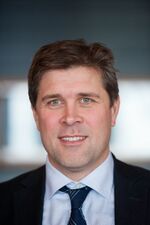
Much of the day to day administration of the Empire is handled by the Imperial Government. The Imperial Government isn't a single body governed by a specific law, but rather the amalgamation of centuries of decrees designed to administrate the Empire and its territories. The Imperial Government is primarily composed of twelve ministries, collectively headed by the Chief Minister. All ministers, including the CM serve entirely at the pleasure of the monarch, and the monarch has the ability to overrule any aspect of the Imperial Government at will.
The Imperial Government can best be described as a large bureaucracy, employing nearly 1 million people in various positions throughout its ranks and across the Empire. The administration of the Empire's infrastructure, education system, pensions, finances, treasury, subnational law enforcement, municipal governments, taxation, and Imperial Lands all happen through the framework of the Imperial Government. The Chief Minister is the appointed head of the Imperial Government, and has broad authority over the administration of the Empire, subject to the monarch's will. Chief Ministers are often informally the public face of the Empire's governing policies, holding press conferences on a regular basis and holding its actions accountable to an extent. As such, it is traditionally the Imperial Government and the Chief Minister that receives the brunt of criticism for failings in government policy or administration, with the monarchy being traditionally sanctified and untouchable - hence off limits in public discourse.
Despite being ultimately at the pleasure of the monarch, the Imperial Government and its ministers have often genuinely played key roles in the history of Aureumterra. Notably, with the appointment of Dr. Erik Rahr as CM in 1980, which was widely seen as the beginning of the Aureumterran Economic Miracle - in large part due to the CM's policies spearheading the economic reforms of the 1980s. The current CM is Jørn Bonde
Imperial Consultative Assembly
The Imperial Consultative Assembly serves as an assembly of advisors to the monarch. The modern institution evolved from the traditional practice of Hæstirétts convening the elders of the various sub-lineages within the Åltæden. All members of the ICA are appointed and serve at the pleasure of the monarch, with over half of its 185 members being Princes or Princesses of the Åltæden. The body traditionally presents decrees to the monarch, with the monarch able to decide whether it gets implemented or not. As such, the ICA is often considered the closest body Aureumterra has to a proper legislature, despite its purely advisory capacity. While the majority of the body's members continue to be from the Åltæden, an increasing number of commoner academics, economists, and military officers have been appointed to the body in the last two eras of Aureumterran history.
Military
The Imperial Armed Forces of Aureumterra is composed of the Imperial Army, Imperial Navy, and Imperial Air Force. The Imperial Armed Forces form one of the largest armed forces in the world, with around 300,000 active duty personnel and nearly 500,000 personnel in reserves. Service is required for all males when they come of age for a minimum period of three years, and remaining in reserves for a further five. Service in the Imperial Armed Forces is often seen as a coming of age rite of passage in Aureumterran society, and military jargon is common among street slang in young men. Women have been allowed to serve in combat roles since 1989, although service is not mandatory for women and all women in the Imperial Armed Forces are volunteers.
Another key element of the Aureumterran security apparatus is the Hæstirévörður (Imperial Guard). The Hæstirévörður is seperate from the Imperial Armed Forces and is made up entirely of volunteers. The institution evolved from the Housecarls of the Åltæden and over time became a parallel military/militia seperate from the general Imperial Armed Forces. The Hæstirévörður's official duties primarily involve serving as protection for the Hæstirétt and senior members of the Åltæden. However, the majority of its members serve in the Krigshæstirévörður, or the combat wing of the Imperial Guard, which fights alongside the general Imperial Armed Forces in active combat. All members of the Hæstirévörður are required to serve a period of thirty years once they enlist, and a large portion of enlistees are cut during the initiation process. The training programme for enlistees is characterized by rigorous political and religious indoctrination, producing what are often labelled as fanatical soldiers. All members of the Hæstirévörður recieve a subsidized home and a regular pension following their service period in retirement.
The Hæstirévörður is subject only to the monarch's authority, however, various monarchs have appointed commanders run the instutiton. The current commander is Heinrik Fjoltsson, appointed in 1980. Aureumterra's intelligence agency, I9, also formally falls under the jurisdiction of the Hæstirévörður, along with the Potens Metropolitan Police and Special Police Units.
Foreign relations
Economy
Aureumterra has what is commonly labelled a state capitalist mixed economy. The state, through the Imperial Assets Agency has a major ownership stake in a significant portion of the Empire's largest corporations, particularly in oil and plastics manufacturing industries. This state sponsored industry is complemented by a large amount of private industry in other sectors, which often have varying degrees of relation to the state itself. Since the 1980s, foreign investment has been a key driver of economic growth in Aureumterra. Many multinational corporations base their manufacturing divisons in the Empire, and a significant amount of expats in management positions live in Aureumterra's large cities.
Today, Aureumterra is the xth largest economy in the world and the xth fastest growing economy by GDP growth per capita. While the rate of growth has slowed down in the 2010s and into the 2020s, it still remains steady and is supplemented by a rapidly growing number of Aureumterran women entering the workforce.
Energy
The majority of Aureumterra's energy, at nearly 65%, still comes from fossil fuels. The Empire has a relatively small but growing renewable energy sector, with large dams on its main central rivers providing power for large swathes of land. Wind energy is also a major source in the central regions of the Heartland, where the flat plains terrain allows for windy conditions year-round. The largest source of alternative energy, however, is nuclear energy, which accounts for thirty percent of the Empire's alternative energy. Plans have been made under Chief Minister Bonde to increase that share to 50% by 2035.
Industry
Aureumterra is home to one of the world's largest manufacturing industries in the world. It has become the global hubs for plastic manufacturing, with x% of the world's plastic products being manufactured in the Empire. Manufacturing is also the largest industry in the country by employment, with nearly 60% of all Aureumterran men and 80% of working women being employed in some form in the industry. Various international labour rights groups and human rights organizations have criticized the conditions at some factories, reporting long hours without breaks and hot and humid work environments. However, the manufacturing industry is also credited as being the main driver of the economic miracle that the Empire underwent in the late 20th and early 21st century.
Infrastructure
Aureumterra's road networks, of which nearly all are paved, are divided into National, Regional, and Local road systems. The primary artery of the national road system is the Motorvej, which connects all of the Empire's largest urban centers in its network. The Motorvej is also notable for having no speed limits. The regional road networks connect urban cores in the Empire to various smaller settlements in their respective local regions.
Road markers in Aureumterra for the Motorvej signify the number of the highway they are on in the system, along with the two endpoints (eg. M1PD for the Motorvej connecting Potens and Drødal). Regional road networks are numbered with the letter of the administrative region they are located in, followed by the individual number of the road (eg. SB98 for the road in the Sudbyar region numbered 98). Local roads all have their own names.
Aureumterra is also serviced by a railroad that connects to all large and most medium sized towns and cities in the Empire. The top twenty largest cities all have a bus system that services all residents. The five largest cities also have a metro system that has stations throughout their urban core and surrounding metro areas, the most famous of them being the Potens Imperial Central located in the Efterbrø district of the capital.
Tourism
Aureumterra has a comparitively smaller but quickly growing tourism sector, particularly in the city of Potens and the coastline of the Nordic Sea. Potens has become renowned for its Old City and imperious neo-classical architectural style, making it by far the Empire's most visited city. The Glæsilegt district is home to many luxury hotels and upscale establishments. Frederiksborg Palace serves as the home to Aureumterra's National Museum, a public access institution that has a collection from throughout the Empire's history. Höll Glæsilegt, the Imperial Palace of Aureumterra and primary residence of the monarch is also a notable attraction from its view in the Glæsilegt district.
The regions of the Nordic Sea Coast have become popular summer destinations for domestic and international tourists since the turn of the 21st century. Its many cliffs, white sand beaches, caves, and nesting sites of birds such as puffins and auks have made it popular among outdoors lovers. Gustavsland Park, the Empire's largest Protected Imperial Land, is home to the largest single nesting site of puffins in the world, and draws thousands of visitors every summer.
Demographics
Aureumterra is home to about 64 million people as of 2023, with a high population growth rate and a relatively high birth rate compared to other Belisarian countries. The majority of population growth in Aureumterra is driven by births, particularly in rural areas, and permanent immigration rates are low. About 40% of the population is below the age of 35, with about 12% being below the age of 13. Aureumterra has a relatively balanced sex ratio, with about 48% of the population comprised of males and 52% comprised of females, with the slight disparity largely being the result of combat deaths in the 20th century wars the Empire was involved in. About 70% of the population is considered urban (including suburban areas), and 30% rural.
The vast majority of Aureumterran citizens, at 94%, identify as ethnic Aureumterrans. The Põjhamaa, at 4%, form the largest ethnic minority group in Aureumterra. The Põjhamaa speak a language of the same name that is closely related to the neighboring Pueramaa language, both being part of the broader Pueramic language group.
Education
Education is mandatory in Aureumterra for primary and secondary school. The complete educational system of Aureumterra consists of five parts, pre-primary education (Præ-Elementære), primary (Elementære), and lower secondary (Folkeskøle) is linear and common for all students. Then, students have a choice between pre-tertiary upper secondary education (Gymnasium) or trade school (Handelsskole). Those who go to Gymnasium are then able to pursue tertiary education with undergraduate and graduate programs offered at universities throughout the Empire, most notably at the Imperial University of Potens. Those attending Handelsskole usually do not pursue tertiary education, however, if they choose to, they must attend a one year course that offers them a Gymnasium-equivalent certification.
All public instruction in Aureumterra happens in the Aureumterran language, with the exception of instutions in Põjhamyrsky, which are taught bilingually in Aureumterran and Põjhamaa.
Religion
The Veldikirkjan (Imperial Church) is the official state religion of the Empire and is adhered to by the vast majority of its population, at around 96%. The most common minority religions are other forms of Christian Sarpetism, including the Fabrian Catholic Church and various protestant denominations. A very small (>1%) of Aureumterra falls outside of the Christian religion, almost entirely composed of expats and recent immigrants.
The Veldikirkjan's presence in daily life in Aureumterra is pervasive. All public educational institutions are required to teach the Church's theology in its religion curriculum, with it being a mandatory credit for graduation from public institutions. Two seperate courts of law exist in the Empire, one which handles purely civil and secular matters, such as most criminal cases and lawsuits, while a seperate, church court arbitrates disputes such as marital issues and religious matters under its own canon law. Lawyers on the bar in one system cannot practice in the other without a seperate course and exam, and experts in church law are called Canonists.
Freedom of religion is heavily restricted in Aureumterra. All minority religions have to be officially registered with the Ministry of Spiritual Affairs, and proselytization for non-Veldikirkjan denominations is illegal. Practice of registered non-Veldikirkjan religions is allowed as long as it is not publicly visible, and the construction of places of worship for other religions is heavily restricted and controlled.
Culture
Music and art
Aureumterra has historically been home to various great orchestral composers, with Aureumterran symphonic composers in particular being renowned in the 19th century. The majority of Aureumterra's modern music however comes from its massive EDM scene. The city of Drødal is sometimes unofficially referred to as the "rave capital of the world" due to its frequent EDM festivals and being home to some of the most renowned DJs in the industry. Aureumterra's EDM has been exemplified by the homegrown genre of Potens House, which became popular in clubs in urban areas of Aureumterra in the 90s and 2000s, and is today considered Aureumterra's biggest cultural export. Well-known DJs and electronic-affiliated artists, such as Elizé, Potens House Mafia, DJ Himmel, and Roland Slide have become world renowned with fanbases across the globe.
Another burgeoning genre oroginating from Aureumterra is Icehop, which began in the working class neighborhoods of Potens as a combination of hip-hop with electronic beats. It is a genre that is rapidly gaining popularity, primarily among the youth.
Aureumterra has a relatively small domestic film industry compared to most of the world. However, some Aureumterran actors and directors such as xxxxx have become famous in the global film industry.
Cuisine
Aureumterran cuisine is based on the staple foods of wheat and rye, which form the basis of the traditional diet in breads of various forms. Sausages are also an important part of traditional Aureumterran cooking, with sausage dishes such as creamed sausages or sausage patties being a common element of winter dinners and breakfasts. Meatballs, specifically spiced meatballs are also another common form of meat consumption, usually served alongside pickled vegetables and a dill-based dipping sauce. Fish is widely consumed, particularly in coastal regions, both as part of a meal or dried as a snack.
Sports
Football is by far the most popular sport in Aureumterra, with the Aureumterran Men's National Team being the xth ranked football team in the world. Aureumterra's domestic football league, Keijserliga, being host to a full three tier club system. The most prominent football clubs in Aureumterra are Potens FC, Potens Imperial, Drødal, Nørrebro FC, Mejksør FC, and Överhallen Utd. Some of the best players in the world, such as Fritz Dalgaard, Anders Egge, and Artur Royse are Aureumterran as well. Football plays a major role in the cultural life of Aureumterra, with players and teams being household names and the fanbases being a dedicated element of Aureumterran life. Football games are large events which often recieve national attention, particularly between major clubs, and traditional football rivalries are deep rooted in Aureumterran society. Hooliganism is a major problem during and around games, with most hooligans and ultras coming from working class urban neighborhoods.
While the vast majority of Aureumterran sporting involves football, other sports also have a smaller but dedicated fanbase in the Empire. Basketball and Pitz both have their own league systems in Aureumterra with the Aureumterran Basketball League and Aureumterran Pitz Association governing them.


